- Unity ユーザーマニュアル 2021.3 (LTS)
- プラットフォーム特有の情報
- Linux
- Linux Player 設定
Linux Player 設定
このページでは、Linux プラットフォームに特化した Player 設定について説明します。一般的な Player 設定の説明は、Player 設定を参照してください。

以下のセクションのプロパティが説明されています。
- Icon (アイコン)
- Resolution and Presentation (解像度と表示)
- Splash Image (スプラッシュ画像)
- Other Settings (その他の設定)
Icon
デスクトップゲームにカスタムアイコンを割り当てるには、Override for Windows, Mac, Linux 設定を有効にします。それぞれの四角に合ったさまざまなサイズのアイコンをアップロードできます。
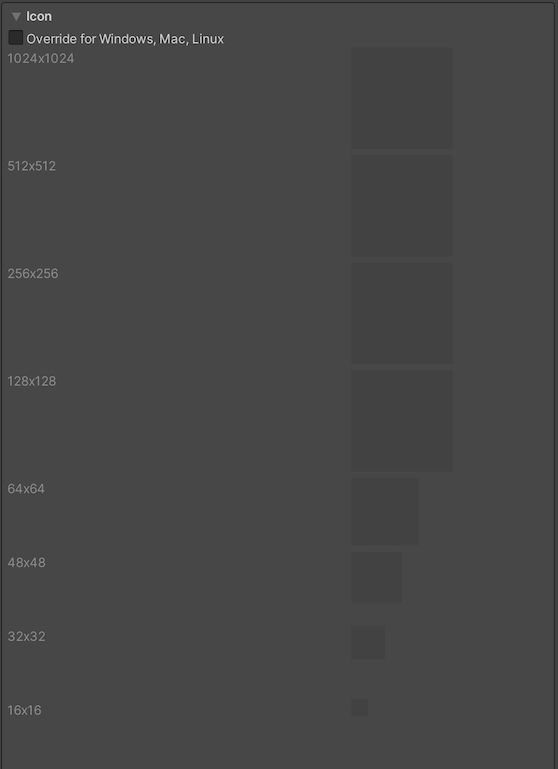
Resolution and Presentation
Resolution and Presentation (解像度と表示) セクションの Resolution と Standalone Player Options を使用して、画面の表示をカスタマイズします。
Resolution
このセクションでは、スクリーンモードとデフォルトサイズをカスタマイズできます。

| プロパティ | 機能 | |
|---|---|---|
| Fullscreen Mode | 全画面のモードを選択します。起動時のデフォルトの画面モードを定義します。 | |
| Fullscreen Window | アプリケーションのウィンドウを、全画面ネイティブディスプレイ解像度に設定し、画面全体を覆うようにします。このモードは、ボーダレスフルスクリーンとも呼ばれます。Unity は、アプリケーションのコンテンツを、スクリプトで設定された解像度 (あるいは、何も設定されていない場合はネイティブディスプレイの解像度) でレンダリングし、ウィンドウいっぱいになるようにスケール (拡大縮小) します。スケール時には、コンテンツが引き伸ばされないように、ディスプレイのアスペクト比に合わせてレンダリング出力に黒帯が追加されます。この処理は レターボックス と呼ばれます。OS のオーバーレイ UI はフルスクリーンウィンドウの上に表示されます (IME 入力ウィンドウなど)。このモードは全てのプラットフォームでサポートされています。 | |
| Exclusive Fullscreen (Windows only) | アプリケーションが、1 つのディスプレイの全画面の独占使用を維持するように設定します。このモードは Fullscreen Window とは異なり、アプリケーションの選択解像度に合わせてディスプレイの OS 解像度を変更します。このオプションは Windows でのみサポートされます。 | |
| Maximized Window (Mac only) | アプリケーションのウィンドウを、オペレーティングシステムの Maximized の定義に合わせて設定します。macOS では、これは通常、フルスクリーンウィンドウで、メニューバーとドックが非表示の状態です。このオプションは macOS でのみサポートされています。他のプラットフォームでは Fullscreen Window がデフォルト設定です。 | |
| Windowed | アプリケーション画面を、標準の、全画面表示ではない移動可能なウィンドウに設定します。ウィンドウサイズはアプリケーションの解像度に依存します。このモードでは、ウィンドウはデフォルトでサイズ変更可能になっています。Resizable Window 設定でこれを無効にできます。この全画面モードは、全てのデスクトッププラットフォームでサポートされています。 | |
| Default Is Native Resolution | ターゲットマシンで使用されているデフォルト解像度をゲームに使用する場合は有効にしてください。Fullscreen Mode が Windowed に設定されている場合は、このオプションは使用できません。 | |
| Default Screen Width | ゲーム画面のデフォルトの幅をピクセル単位で設定します。このオプションは、Full Screen Mode が Windowed に設定されている場合にのみ使用できます。 | |
| Default Screen Height | ゲーム画面のデフォルトの高さをピクセル単位で設定します。このオプションは、Full Screen Mode が Windowed に設定されている場合にのみ使用できます。 | |
| Mac Retina Support | Mac で高 DPI (Retina) 画面をサポートするには、このオプションを有効にしてください。Unity はこれをデフォルトで有効に設定します。有効にすると Retina ディスプレイのプロジェクトの質が向上しますが、リソースの負荷が若干高くなります。 | |
| Run In background | このオプションを有効にすると、アプリケーションがフォーカスを失った場合に、ゲームが一時停止せず、実行され続けます。 | |
Standalone Player Options
このセクションを使って、画面をカスタマイズできます。例えば、ユーザーが画面のサイズを変更できるかどうかや、同時に実行できるインスタンスの数などを決定できます。
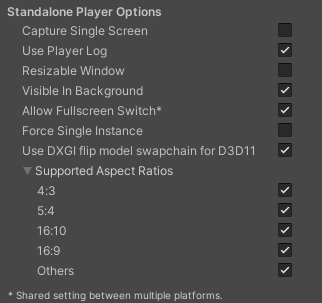
| プロパティ | 機能 |
|---|---|
| Capture Single Screen | これを有効にすると、全画面モード のデスクトップゲームで、マルチモニター設定時に補助モニターが暗くならないようにします。Mac OS X ではサポートされていません。 |
| Use Player Log | これを有効にすると、デバッグ情報を含むログファイルを作成します。デフォルトは有効です。 注意 アプリケーションを Mac App Store に提出する場合は、このオプションを無効にします。詳細は、Mac App Store へ公開 を参照してください。 |
| Resizable Window | これを有効にすると、プレイヤーウィンドウサイズを変更できます。 ノート: このオプションを無効にすると、アプリケーションは Fullscreen Mode の Windowed が使用できなくなります。 |
| Visible in Background | これを有効にすると、Windows で Fullscreen Mode の Windowed が使用されている場合に、アプリケーションを背景で表示します。 |
| Allow FullScreen Switch | これを有効にすると、デフォルトの全画面キーを押して全画面のモードと Windowed モードを切り替えることができます。 |
| Force Single Instance | これを有効にすると、デスクトッププレイヤーを 1 つの同時実行インスタンスに制限できます。 |
| Supported Aspect Ratios | 起動時に解像度ダイアログに表示したいアスペクト比を有効にします (ユーザーのモニターにサポートされている場合)。 |
Splash Image
Virtual Reality Splash Image 設定を使用して、VR ディスプレイのカスタムスプラッシュ画像を指定します。一般的なスプラッシュスクリーン の設定については、スプラッシュスクリーン を参照してください。
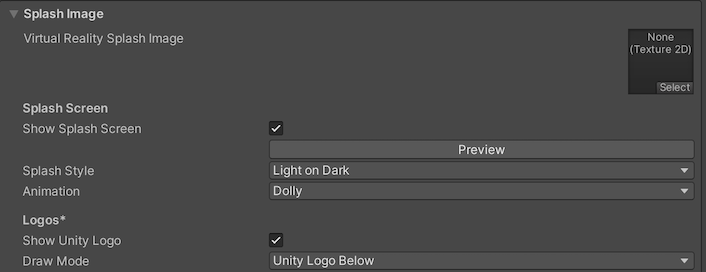
Other Settings
Other Settings のセクションでは、以下のグループに分類されたさまざまなオプションをカスタマイズできます。
- Rendering (レンダリング)
- Vulkan Settings (Vulkan 設定)
- Mac App Store Options (Mac App Store オプション)
- Configuration (設定)
- Optimization (最適化)
- Logging (ログ)
- Legacy (古い機能)
Rendering
これらの設定を使用して、デスクトップ (Windows、Mac、Linux) プラットフォーム向けにゲームをレンダリングする方法をカスタマイズします。
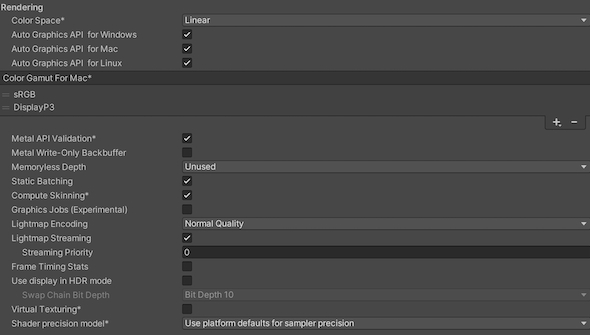
| Property | Description | |
|---|---|---|
| Color Space | Choose which color space Unity uses for rendering: Gamma or Linear. See the Linear rendering overview for an explanation of the difference between the two. • Gamma: Gamma color space is typically used for calculating lighting on older hardware restricted to 8 bits per channel for the framebuffer format. Even though monitors today are digital, they might still take a gamma-encoded signal as input. • Linear: Linear color space rendering gives more precise results. When you select to work in linear color space, the Editor defaults to using sRGB sampling. If your Textures are in linear color space, you need to work in linear color space and disable sRGB sampling for each Texture. |
|
| Auto Graphics API for Windows | Windows用自動グラフィックスAPIを有効にすると、ゲームが実行されている Windows マシンで最善のグラフィックス API が使用されます。サポートされているグラフィックス API の追加や削除を行うには、無効にしてください。 | |
| Auto Graphics API for Mac | 有効にすると、実行される Mac マシンで最善のグラフィックス API が使用されます。サポートされているグラフィックス API の追加や削除を行うには、無効にしてください。 | |
| Auto Graphics API for Linux | 有効にすると、実行される Linux マシンで最善のグラフィックス API が使用されます。サポートされているグラフィックス API の追加や削除を行うには、無効にしてください。 | |
| Color Gamut for Mac | You can add or remove color gamuts for the Mac platform to use for rendering. Click the plus (+) icon to see a list of available gamuts. A color gamut defines a possible range of colors available for a given device (such as a monitor or screen). The sRGB gamut is the default (and required) gamut. | |
| Metal API Validation | シェーダーの問題をデバッグする必要がある場合は、これを有効にします。 ノート: Validation は CPU 使用率を増加させるため、デバッグにのみ使用してください。 |
|
| Metal Write-Only Backbuffer | Allow improved performance in non-default device orientation. This sets the frameBufferOnly flag on the back buffer, which prevents readback from the back buffer but enables some driver optimization. | |
| Memoryless Depth | いつ メモリレスレンダーテクスチャ を使用するかを選択します。メモリレスレンダーテクスチャはレンダリング時に、CPU や GPU メモリではなく、タイル上のメモリに一時的に格納されます。これにより、アプリケーションのメモリ使用量が削減されますが、これらのレンダーテクスチャに対して読み取り/書き込みを行うことはできません。 ノート: メモリレスレンダーテクスチャは、tvOS、tvOS 10.0以降 Metal、Vulkan でのみサポートされます。レンダーテクスチャは読み取り/書き込み保護され、他のプラットフォームの CPU または GPU メモリに保存されます。 |
|
| Unused | メモリレスフレームバッファ深度を決して使用しません。 | |
| Forced | 常にメモリレスフレームバッファ深度を使用します。 | |
| Automatic | メモリレスフレームバッファ深度をいつ使用するかは Unity が決定します。 | |
| Static Batching | Enable this option to use Static batching. | |
| Dynamic Batching | Enable this option to use Dynamic Batching on your build (enabled by default). Note: Dynamic batching has no effect when a Scriptable Render Pipeline is active, so this setting is only visible when nothing is set in the Scriptable Render Pipeline Asset Graphics setting. |
|
| Compute Skinning | DX11/ES3 GPU コンピュートスキニングを使用するには、CPU リソースを解放します。 | |
| Graphics Jobs | Enable this option to instruct Unity to offload graphics tasks (render loops) to worker threads running on other CPU cores. This is intended to reduce the time spent in Camera.Render on the main thread, which is often a bottleneck. |
|
| Lightmap Encoding | Choose Normal Quality or High Quality to set the lightmap encoding. This setting affects the encoding scheme and compression format of the lightmaps. | |
| Lightmap Streaming | Whether to use Mipmap Streaming for lightmaps. Unity applies this setting to all lightmaps when it generates them. Note: To use this setting, you must enable the Texture Streaming Quality setting. |
|
| Streaming Priority | Set the priority for all lightmaps in the Mipmap Streaming system. Unity applies this setting to all lightmaps when it generates them. Positive numbers give higher priority. Valid values range from –128 to 127. |
|
| Frame Timing Stats | Enable this property to gather CPU and GPU frame time statistics. Use this together with the Dynamic Resolution camera setting to determine if your application is CPU or GPU bound. | |
| Use Display In HDR Mode (Windows Only) | Enable this checkbox to make the game automatically switch to HDR mode output when it runs. This only works on displays that support this feature. If the display does not support HDR mode, the game runs in standard mode. | |
| Swap Chain Bit Depth | Select the number of bits in each color channel for swap chain buffers. Only available if HDR Mode is enabled. | |
| Bit Depth 10 | Unity will use the R10G10B10A2 buffer format and Rec2020 primaries with ST2084 PQ encoding. | |
| Bit Depth 16 | Unity will use the R16G16B16A16 buffer format and Rec709 primaries with linear color (no encoding). | |
| Virtual Texturing | Indicates whether to enable Virtual Texturing. Note: The Unity Editor requires a restart for this setting to take effect. |
|
| Shader precision model | Controls the default precision of samplers used in shaders. See Shader data types and precision for more details. | |
| 360 Stereo Capture | Indicates whether Unity can capture stereoscopic 360 images and videos. When enabled, Unity compiles additional shader variants to support 360 capture (currently only on Windows/OSX). When enabled, enable_360_capture keyword is added during the Stereo RenderCubemap call. Note that this keyword is not triggered outside the Stereo RenderCubemap function. For more information, see Stereo 360 Image and Video Capture. |
|
Vulkan Settings

| プロパティ | 説明 |
|---|---|
| SRGB Write Mode | このオプションを有効にすると、Graphics.SetSRGBWrite() レンダラーが、ランタイム中に sRGB 書き込みモードを切り替えられるようになります。つまり、リニアから sRGB への書き込み色変換を一時的にオフにしたい場合は、このプロパティを使用してそれを行えます。有効にした場合、モバイルのタイルベース GPU のパフォーマンスに悪影響を与えるので、モバイルでは有効にしないでください。 |
| Number of swapchain buffers | このオプションを 2 に設定するとダブルバッファリング、3 に設定するとトリプルバッファリングが、Vulkan レンダラーに使用されます。この設定は、一部のプラットフォームでは待ち時間の改善に役立つ場合がありますが、ほとんどの場合はデフォルト値の 3 のままにすることが推奨されます。ダブルバッファリングはパフォーマンスに悪影響を及ぼす可能性があります。Android ではこの設定は使用しないでください。 |
| Acquire swapchain image late as possible | 有効にすると、Vulkan は、バックバッファの取得を遅らせ、フレームをオフスクリーン画像にレンダリングした後でそれを行います。Vulkan は、ステージング画像を使用してこれを行います。この設定を有効にすると、バックバッファを表示する時に Blit が 1 つ追加で発生します。この設定とダブルバッファリングを組み合わせることで、パフォーマンスを向上させることができます。ただし、追加の Blit が帯域幅を使用するため、パフォーマンスの問題を引き起こす可能性もあります。 |
| Recycle command buffers | Unity が CommandBuffers を実行した後に、それを再利用するか解放するか指定します。 |
Mac App Store Options

このセクションのプロパティは、macOS にのみ関連します。詳しくは、macOS の Player 設定 を参照してください。
Configuration

| 設定 | 機能 | |
|---|---|---|
| Scripting Backend | 使用したいスクリプティングバックエンドを選択します。スクリプティングバックエンドは Unity のプロジェクトで C# コードをコンパイルし実行する方法を決定します。 | |
| Mono | C# コードを .NET Common Intermediate Language (CIL) にコンパイルし、それを Common Language Runtime を使用して実行します。詳細は、Mono プロジェクト に関するウェブサイトを参照してください。 | |
| IL2CPP | C# コードを CIL にコンパイルし、CIL を C++ に変換し、次に、その C++ をネイティブのマシンコードにコンパイルします。これは、ランタイムに直接実行されます。詳細は IL2CPP を参照してください。 | |
| API Compatibility Level | プロジェクトに使用する .NET API を選択します。この設定は、サードパーティ製ライブラリとの互換性に影響を与えます。 ヒント サードパーティ製アセンブリに問題がある場合は、後述の API Compatibility Level セクションを参照してください。 |
|
| .Net Standard | .NET Standard 2.0 と互換性があります。ビルドは小さく、完全なクロスプラットフォームをサポートします。 | |
| .Net Framework | .NET Framework 4 (.NET Standard 2.0 プロファイルのすべてと追加 API を含む) と互換性があります。.NET Standard 2.0 に含まれていない API にアクセスするライブラリを使用する場合は、このオプションを選択します。より大きいビルドが作成され、使用可能な追加の API がすべてのプラットフォームで必ずしもサポートされるわけではありません。詳細は、追加のクラスライブラリアセンブリの参照 を参照してください。 | |
| C++ Compiler Configuration | IL2CPP 生成コードをコンパイルするときに使用する C++ コンパイラーの設定を選択します。 ノート このプロパティは、Scripting Backend が IL2CPP に設定されない限り、無効です。 |
|
| Use incremental GC | Enable this to use the incremental garbage collector, which spreads garbage collection over several frames to reduce gc-related spikes in frame duration. | |
| Active Input Handling | ユーザーからの入力をどのように処理するかを選択します。 | |
| Input Manager (old) | Use the default Input window. | |
| Input System (Preview) | 新しい Input (入力) システムを使用します。入力システムはこのリリースのプレビューパッケージとして提供されています。Input System のプレビュー版を使用するには、InputSystem パッケージ をインストールしてください。 | |
| Both | 両方のシステムを同時に使用できます。 | |
API Compatibility Level
すべてのターゲットに対する Mono の API Compatibility Level (API 互換性レベル) を選択できます。時にはサードパーティ製の .NET ライブラリが、.NET 互換性レベル外の機能を使用することがあります。そのような場合に何が起きているか理解し、最良の修正処理を行うためには、以下を試みてください。
- Windows 用 ILSpy をインストールします。
- 問題のある API 互換性レベルの .NET アセンブリを ILSpy にドラッグします。これらは
Frameworks/Mono/lib/mono/YOURSUBSET/の下にあります。 - サードパーティ製のアセンブリをドラッグします。
- サードパーティ製のアセンブリを右クリックし、Analyze を選択します。
- 分析レポートの中で、Depends on セクションを調べます。サードパーティ製品依存でありながら、選択した .NET 互換性レベルで対応しないものはすべてここで赤字でハイライトされます。
Script Compilation
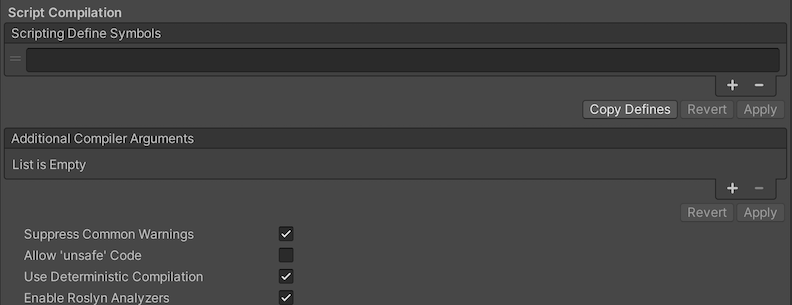
| 設定 | 機能 | |
|---|---|---|
| Scripting Define Symbols | Set custom compilation flags. For more details, see the documentation on Platform dependent compilation. | |
| Additional Compiler Arguments | Add entries to this list to pass additional arguments to the Roslyn compiler. Use one new entry for each additional argument. To create a new entry, press the ‘+’ button. To remove an entry, press the ‘-’ button. When you have added all desired arguments, click the Apply button to include your additional arguments in future compilations.The Revert button resets this list to the most recent applied state. |
|
| Suppress Common Warnings | Disable this setting to display the C# warnings CS0169 and CS0649. | |
| Allow ‘unsafe’ Code | Enable support for compiling ‘unsafe’ C# code in a pre-defined assembly (for example, Assembly-CSharp.dll). For Assembly Definition Files ( .asmdef), click on one of your .asmdef files and enable the option in the Inspector window that appears. |
|
| Use Deterministic Compilation | Disable this setting to prevent compilation with the -deterministic C# flag. With this setting enabled, compiled assemblies are byte-for-byte identical each time they are compiled. For more information, see Microsoft’s deterministic compiler option documentation. |
|
| Enable Roslyn Analyzers | Disable this setting to compile user-written scripts without Roslyn analyzer DLLs that might be present in your project. | |
Optimization

| プロパティ | 説明 | |
|---|---|---|
| Prebake Collision Meshes | Enable this option to add collision data to Meshes at build time. | |
| Keep Loaded Shaders Alive | When enabled, you cannot unload a shader. See Shader Loading for more information. | |
| Preloaded Assets | Set an array of Assets for the player to load on startup. To add new Assets, increase the value of the Size property, then set a reference to the Asset to load in the new Element box that appears. |
|
| AOT compilation options | Ahead of Time (AOT) コンパイルの追加オプション。これは、ビルドした iOS プレイヤーのサイズ最適化 に役立ちます。 | |
| Strip Engine Code | Enable this option if you want the Unity Linker tool to remove code for Unity Engine features that your Project doesn’t use. This setting is only available with the IL2CPP scripting backend. Most apps don’t use every available DLL. This option strips out DLLs that your app doesn’t use to reduce the size of the built Player. If your app is using one or more classes that would normally be stripped out under your current settings, Unity displays a debug message when you try to build the app. |
|
| Managed Stripping Level | Choose how Unity strips unused managed (C#) code.The options are Disabled Low, Medium, and High. When Unity builds your app, the Unity Linker process can strip unused code from the managed DLLs your Project uses. Stripping code can make the resulting executable significantly smaller, but can sometimes accidentally remove code that is in use. For more information about these options, see documentation on Managed code stripping. For information about bytecode stripping with IL2CPP, see documentation on Managed bytecode stripping with IL2CPP. |
|
| Vertex Compression | Choose the channel that you want to set for compressing meshes under the vertex compression method, which by default, is set to Mixed. This affects all the meshes in your project. Typically, Vertex Compression is used to reduce the size of mesh data in memory, reduce file size, and improve GPU performance. For information on how to configure vertex compression and limitations of this setting, see [compressing meshes]. | |
| Optimize Mesh Data | Selecting this option enables stripping of unused vertex attributes from the mesh used in a build. This reduces the amount of data in the mesh, which might help reduce build size, loading times, and runtime memory usage. However, you must remember to not change material or shader settings at runtime, if you have this setting enabled. See PlayerSettings.stripUnusedMeshComponents for more information. |
|
| Texture MipMap Stripping | Enable this option to enable mipmap stripping for all platforms, which strips unused mipmaps from Textures at build time. Unity determines unused mipmaps by comparing the value of the mipmap against the Quality Settings for the current platform. If a mipmap value is excluded from every Quality Setting for the current platform, then Unity strips those mipmaps from the build at build time. If QualitySettings.masterTextureLimit is set to a mipmap value that has been stripped, Unity will set the value to the closest mipmap value that has not been stripped. | |
Logging
特定のコンテキストで許可するログのタイプを選択します。
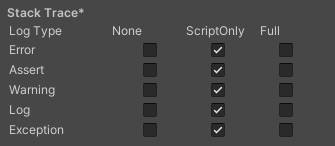
Select your preferred logging method from the available options.
- Check a box that corresponds to each Log Type (Error, Assert, Warning, Log, and Exception) based on the type of logging you require. For example:
- ScriptOnly: Logs only when running scripts.
- Full: Logs all the time.
- None: No logs are ever recorded.
詳しくは、スタックトレースロギング を参照してください。
Legacy

| プロパティ | 機能 |
|---|---|
| Clamp BlendShapes (Deprecated) | これを有効にすると、SkinnedMeshRenderers でブレンドシェイプのウェイトの範囲を固定できます。 |
| Upload Cleared Texture Data | これは古い機能で現在は必要ありません。なぜなら、帯域幅を使用するからです。デフォルトでは、デバッグのために有効になっています。この設定を有効にすると、初期データがクリアされ、テクスチャがスクリプトからビデオメモリに自動的にアップロードされます。 |